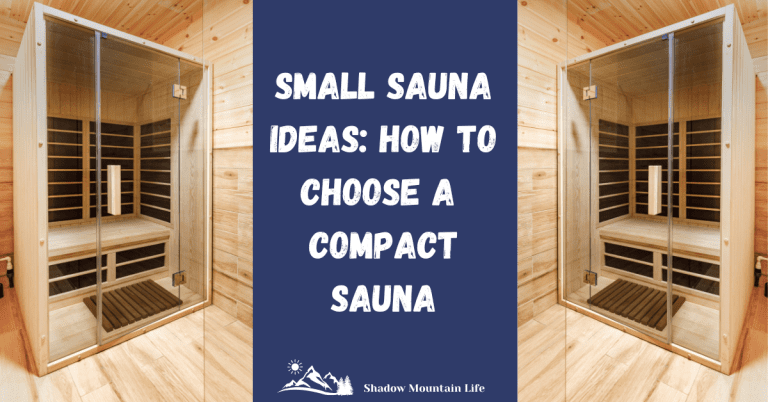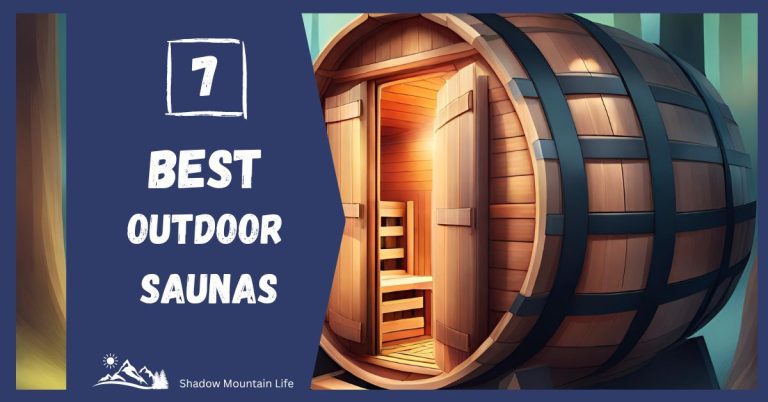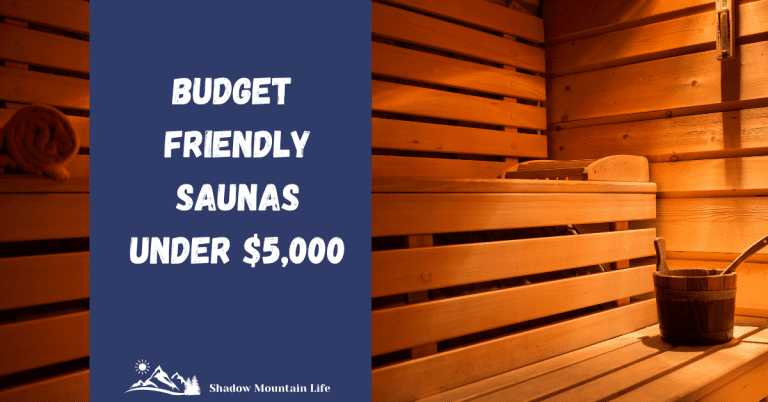Indoor vs Outdoor Sauna: Which One Is Right for You?
Medical Disclaimer: We are not doctors. The health information in the article is for informational and educational purposes only. Please consult your doctor or other healthcare professional when making medical decisions.
Affiliate Disclaimer: We may make a commission if you purchase something through our links. Thank you!
Did you know that the global sauna market is projected to reach $1.27 billion by 2030? With such impressive growth, it’s clear that they are more than just a passing trend and that saunas provide a legit health benefit.
While saunas have been used for thousands of years in the Scandinavian countries, they are becoming increasingly popular and accessible in the US market. But when it comes to choosing between indoor and outdoor saunas, homeowners are often left wondering which is the best for them.
There are benefits and drawbacks of both indoor and outdoor saunas and understanding the key differences can help you make the perfect choice for your home.
Understanding the Basics: Indoor vs Outdoor Saunas
When I first started exploring saunas, I learned that there is a world of difference between indoor and outdoor sauna setups.
Indoor saunas are like the introverts of the sauna world – they’re contained, controlled, and super convenient. They are protected from the elements as these saunas are built right into your home, often in a spare bathroom, basement, or even a home gym. The big win here is climate control. No matter if it’s freezing outside or humid as a rainforest, your indoor sauna stays consistent. I’ve seen some pretty nice setups where people have turned a small space in a basement into a personal wellness sanctuary.
Outdoor saunas? They’re the extroverted cousins. These units stand separately from your main house, often in a backyard or garden setting. They’re like a mini retreat right in your own yard. My husband built our sauna about 5 years ago placed just off the patio. Over time he’s added a cold plunge tub as well. It’s a simple set-up, but so effective and we feel like we are on vacation every time we use it.
The materials make a huge difference too. Most saunas – whether indoor or outdoor – use specific types of wood that can handle intense heat and moisture. Cedar is the most popular because it’s naturally resistant to humidity and prevents mold growth.
One thing that surprised me was how much technology has transformed saunas. We’re not talking about a basic wooden box anymore. Modern saunas – both indoor and outdoor – come with digital controls, infrared heating elements, and some even have smartphone integration where you can turn on your sauna while you are on your way home from work!
Cost is another factor that will be an important thing to consider. Indoor saunas can range from a few thousand to tens of thousands of dollars depending on how fancy you want to get. Outdoor units? Similar price range, but you’ve got additional considerations like foundation work and weatherproofing.
Pros and Cons of Indoor Saunas

Indoor saunas provide an instant upgrade to a home wellness space. But they’re not without their quirks and challenges.
Convenience is the best thing about indoor saunas. Imagine stepping out of your bedroom, padding down the hallway, and sliding into a perfect heated sanctuary without ever touching outdoor weather. No ice, no snow, just pure relaxation waiting for you.
But convenience comes with some serious considerations. First off, space is a major player in this game. Indoor saunas aren’t just something you can randomly plop down like a piece of IKEA furniture. You do need dedicated square footage that can handle high humidity, heat, and potential moisture damage.
The privacy factor? Absolutely unbeatable. No worrying about neighbors, no dealing with outdoor elements, just pure, personal relaxation. You control the environment completely. Temperature, humidity, lighting – it’s all in your hands.

Cost-wise, indoor saunas aren’t for the faint of wallet. We’re talking serious investment. Basic models like the Sunray Traditional Sauna start around $3,000, but high-end infrared/steam combo like the Finnmark FD-5 Trinity XL or traditional Finnish-style saunas like the Auroom Cala can easily be $10,000 and up. And that’s before you factor in installation, which can be complex depending on your home’s layout.
Ventilation is something most people don’t think about until it’s too late. Indoor saunas generate massive amounts of moisture, and if you don’t have proper drainage and air circulation, you’re looking at potential mold nightmares, so proper ventilation is key!
Make sure to invest in a good exhaust system and consider ceramic tiles or other water-resistant flooring around your sauna area.
Electrical requirements are another hidden complexity. Most indoor saunas need dedicated electrical circuits of 240 Volts, and depending on your home’s current setup, you might be looking at some serious electrical work. Don’t skimp on the electrical – it’s not worth the risk. Make sure to hire a hire a professional!
One unexpected bonus? Property value. A well-installed, professional indoor sauna can be a serious selling point. It’s like a luxury amenity that screams “this homeowner takes wellness seriously and you can too.”
Your thoughts may vary, but for me, the pros of an indoor sauna significantly outweigh the cons. Just go in with your eyes wide open, do your research, and be prepared for a bit of an investment – both financially and in terms of home modification.
Indoor Sauna Pros
Indoor Sauna Cons
Pros and Cons of Outdoor Saunas

I love outdoor saunas! And it’s not only because that’s what we have. I love that the sauna is separate from the house, and it is a quiet retreat. I love that I can cool down and walk barefoot in the yard while also looking up at the stars. My husband loves the outdoor sauna as he can have buddies over and they can hang out on the patio in between sauna sessions.
The biggest difference between an indoor and outdoor sauna is the ability to choose a beautiful location, and this is where I believe they take some serious points from indoor saunas. Unlike indoor saunas that are stuck inside four walls, outdoor saunas let you create an entire experience in natural surroundings.
If you choose to go with a traditional sauna, with a wood-burning stove, you can place it by a lake, river, or beach- wherever you like as you don’t need to plug it in. A picturesque barrel sauna beside a lake is a beautiful sight to see!
Outdoor saunas involve considering landscape integration and how it will look on your patio or backyard. They can be beautiful architectural statements, and they can also blend seamlessly with your existing landscaping, almost becoming part of the natural environment. I’ve seen some setups that look like they’ve been lifted straight out of a Scandinavian design magazine. Finnleo saunas does an incredible job of creating a seamless design with a high-quality product in your outdoor space!
Weather is the number one enemy for an outdoor sauna. We’re talking potential wood warping, moisture damage, and constant maintenance.
Durability becomes your new obsession. Rain, snow, extreme temperatures, UV exposure – you name it. Cedar and thermally modified wood become your best friends. These materials can handle moisture and temperature shifts like champions.

Cost-wise, outdoor saunas can get pricey. You’re not just paying for the sauna itself – you’re investing in foundation work, weatherproofing, potential electrical upgrades, and landscaping modifications. The range of prices varies from $4,500 for a barrel sauna, approximately $7,000 for the above Dundalk Cabin Sauna and all the way up to $24,000 for the Auroom Mira Cabin. And believe me, there are higher options out there!
Privacy becomes an interesting dance with outdoor saunas. Some people love the open-air feeling, while others start getting nervous about neighbors. Strategic placement and clever landscaping become important. Think privacy fencing, strategic plant placement, maybe even a small surrounding deck to create a more secluded experience.
Energy efficiency is another consideration. Outdoor saunas actually have some surprising advantages. Because they’re separate from your main living space, you’re not dumping heat into your home’s internal environment. Plus, many modern outdoor saunas come with seriously impressive insulation technologies.
Installation complexity is no joke. You’ll need to consider electrical connections, potential plumbing for a shower or cooling area, proper drainage, and foundation requirements. My recommendation? Work with professionals who specialize in outdoor wellness spaces. DIY might save money upfront, but it’ll cost you in headaches later.
Outdoor Sauna Pros
Outdoor Sauna Cons
Cost Comparison: Indoor vs Outdoor Sauna Investments
Money talks, especially when we’re discussing the world of home wellness investments. Let’s break down the basic price ranges. Indoor saunas typically start around $3,000 for a basic model and can rocket up to $20,000 for a high-end, custom installation.
Outdoor saunas? Budget models start around $4,000, but a fully tricked-out outdoor sauna can easily hit $30,000 or more.
The hidden costs are where things get spicy. For indoor saunas, you’re looking at:
– Electrical work
– Flooring reinforcement
– Ventilation modifications
– Potential bathroom or room remodeling
Outdoor saunas have their own financial obstacle course:
– Foundation preparation
– Weatherproofing
– Electrical run to external building
– Landscaping modifications
Energy costs are another important consideration. Indoor saunas typically cost about $3-$6 per hour to operate, depending on your local electricity rates. Outdoor saunas can be slightly less efficient, potentially running $4-$8 per hour due to heat loss and environmental factors.
Now if you have a wood-burning sauna and a large supply of wood available, you can cut your costs even further!
A well-installed sauna can actually increase your property value. We’re talking potentially a 5-10% bump in home value, depending on your local market. Many people are willing to pay more as they see the value in a home sauna.
Maintenance is where the long-term investment really shows. Indoor saunas are slightly easier to maintain – you’re talking about $200-$500 annually for professional cleaning and wood treatment. Outdoor saunas? Budget closer to $500-$1,000 annually due to more intense environmental exposure.
Material choices dramatically impact cost. Traditional Finnish-style wood saunas? More expensive. Infrared technology? Typically, cheaper to install but different operating costs. Hemlock, cedar, Nordic spruce – each wood type comes with its own price tag and maintenance requirements.
Insurance is another factor most people forget. An indoor sauna might slightly increase your home insurance, typically $50-$100 annually. Outdoor saunas can be a bit more complex, potentially adding $100-$300 to your annual premium.
A non-visible benefit? Potential health savings. Some health insurance plans are starting to recognize sauna use as a preventative wellness strategy. We’re talking potential discounts or wellness program credits. Check your health insurance and see what they offer.
A final piece of advice: Don’t just look at the upfront cost. Consider the total cost of ownership. A cheaper sauna that requires constant repairs isn’t a bargain. A slightly more expensive, high-quality installation that runs smoothly for years? That’s the real investment.
Practical Considerations for Sauna Selection
Some practical considerations for installing an indoor or outdoor sauna include how much space you have, your climate, how much you expect to use the sauna and how many people will be using it too.
1. Space
Space is the first reality check. Most people drastically overestimate how much room they actually have. A typical indoor sauna needs about 4×4 feet at minimum, while outdoor saunas require even more consideration.
2. Climate
Climate plays a massive role that most people completely overlook. If you’re living in Minnesota, your outdoor sauna needs are wildly different from someone in Arizona. Extreme cold requires serious insulation and heating capacity. Hot, humid climates? You’ll need next-level ventilation and materials that can withstand constant moisture to prevent mold.
3. Usage
Personal usage patterns are critical. Are you a daily sauna user or a weekend warrior? Someone using a sauna multiple times a week needs a different setup than someone who might use it once a month.
4. Health
Health considerations matter more than most people realize. If you have specific health conditions – heart issues, blood pressure concerns, pregnancy – you’ll want to consult with a healthcare professional before making your final selection.
Not all saunas are created equal when it comes to health benefits. Sometimes choosing an infrared sauna offering lower temperatures will make much more sense than a traditional sauna depending on your health state and goals.
5. Customization
Customization options have exploded in recent years. We’re talking custom wood choices, integrated sound systems, chromotherapy lighting, built-in shower features. The options are almost overwhelming. My advice? Focus on functionality first, then get fancy.
Further Research
There is a huge variety of both indoor and outdoor saunas available on the market today for a variety of prices and budgets. To give you a good idea of what’s out there check out a few of the following websites:
1. Nordica Saunas
Outdoor and indoor saunas, infrared, traditional and combination infrared/steam saunas available.
2. Sun Home Saunas
Outdoor and indoor saunas, infrared and traditional steam saunas.
3. Finnleo Saunas
If you are looking for a beautiful custom sauna inside or outside, check out Finnleo!
The perfect sauna isn’t about finding the most expensive model or the most technologically advanced system. It’s about finding the right type of sauna that fits your space, your lifestyle, and your wellness goals as well as your personal preference. Take your time, do your research, and remember – this is an investment in your health and home that you will not regret.







